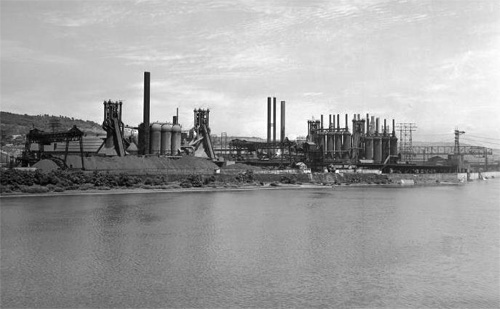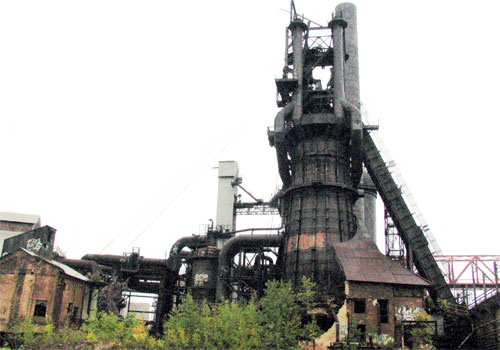
Carrie, Have You Seen Better Days?
By BOB CIMINEL
July 21, 2011
Friday
With the demise of the steel industry in Pittsburgh, Pennsylvania, in the early 1980s, most of the mills were torn down and the land turned into high-priced real estate. This was all riverfront property, and with man’s affinity for water, the land became a developer’s dream. About the only things that were not removed were the railroad tracks.
One of the largest mills that fell to the scraper’s torch was the former Homestead Works, opened around 1881 and purchased by Andrew Carnegie in 1883. Homestead gained notoriety in 1892 when striking steelworkers clashed with Pinkerton guards in a day-long battle that ended with at least 11 dead and scores injured. The only structures left at Homestead are the pump house and water tank, which are the centerpieces of the Rivers of Steel National Heritage Area.

Carrie Furnace c.1940
Standing at the pump house, one can gaze across the Monongahela River and see two monstrous structures soaring above the tree-lined bank. This is Carrie Furnace; or rather the remnants of Carrie Furnaces No. 6 and 7, which operated between 1907 and 1978, producing iron from ore, limestone and coke. At 92 feet tall, the furnaces and the huge ore bridge that moved the iron ore, limestone and coke to the skip cars where it was dumped into the tops of furnaces, are the most imposing structures. Next to the furnaces are banks of ovens that heated the compressed air that gave the furnaces their designation as blast furnaces.
Over its lifetime, Carrie Furnace was comprised of seven blast furnaces. In 1900, Furnace No. 3 set a record by producing 790 tons of iron in 24 hours. With improvements in technology, by the time they closed in 1978, Furnaces 6 and 7 could each produce over 1,200 ton of iron a day. The molten iron was poured into cigar-shaped hot metal cars and transported by rail over the appropriately named Hot Metal Bridge to the Homestead Works where it was turned into steel and formed into ingots for further finishing.

Carrie Furnace #7 2008
Photo by Bob Ciminel ©2011
Carrie Furnace, although abandoned, was saved from destruction by Allegheny County, which purchased the 135-acre site from the developer for almost $6 million. The furnaces are still in disrepair, but are available for tours through the Rivers of Steel museum.
When the author toured the furnaces on the first public tour in 2008, the tour guides were former workers from Carrie Furnace, who quickly pointed out that were ironworkers, not steelworkers. They also described the working conditions around the blast furnaces, which were hot, dirty and noisy, and consequently jobs for which only African Americans were “qualified.”
Carrie Furnace will be preserved as a historical landmark and opened for public access after the Hot Metal Bridge is adapted to automobile and pedestrian traffic. It serves as an imposing, mysterious and almost spooky reminder of America’s industrial past.
Biography
©2011 Bob Ciminel has been in the commercial nuclear industry for the past 40 years, working in radiation protection, operations, training and quality assurance. He has licensed or certified as a Senior Reactor Operator at five commercial nuclear plants. Bob lives in Roswell, Georgia.
Contact Bob Ciminel: bobciminel@yahoo.com
E-mail your news &
photos to editor@sitnews.us
Publish A Letter in SitNews Read Letters/Opinions
Contact the Editor
SitNews ©2011
Stories In The News
Ketchikan, Alaska
|
Articles &
photographs that appear in SitNews may be protected by copyright
and may not be reprinted without written permission from and
payment of any required fees to the proper sources.
|
|


